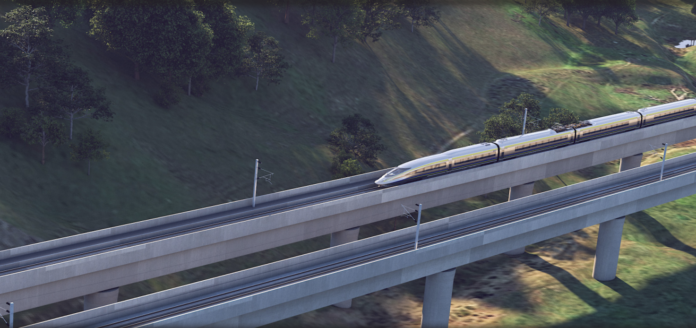Since Gov. Gavin Newsom’s first State of the State address six years ago, California has stopped pursuing a high-speed rail system that actually connects the Bay Area to Southern California, as was promised to voters in 2008. And in that void, politicians, pundits and a mostly partisan minority of voters howled and cried boondoggle, discounting the new focus—building only the Central Valley segment—in the same breath.
In a project update for state lawmakers released last week, the California High-Speed Rail Authority unveiled the latest ridership and revenue projections for the Central Valley line and several other potential routes. The new data—the project’s first in two years—paints a harsh picture of an unprofitable bullet train, beset by too few riders in the state’s agricultural heartland, and costs for upkeep that would dwarf the money it makes unless it expands.
Authority officials have previously acknowledged that the 171-mile Merced to Bakersfield line would require a subsidy to operate, a point often drowned out in the narrow debate that surrounds the project. Authority CEO Ian Choudri, now one year into the job, seems to be betting that a blunt conversation and new funding strategy—free of government aid—could convince lawmakers to endorse a new direction.
But there’s a potential catch: It only might be feasible if the project is allowed to put the northernmost extension to Merced on hold.
Salvation for high-speed rail apparently lies in Gilroy, the world’s garlic capital, and its potential to connect Silicon Valley to the Central Valley—or even as far south as Palmdale—by 2038. As the southern terminus for the Caltrain system, the agrarian city has long been considered high-speed rail’s best chance of reaching San Francisco.
It’s a bold vision worth supporting, despite the significant technical, legal, regulatory and political hurdles. Choudri, who has previously worked on high-speed rail in France and Spain, appears dead set on ending the project’s reliance on fluky government grants and attracting private investors, as many foreign bullet trains have done.
“I was not coming here to just say, ‘What is authorized to build?’” Choudri said in an interview. “I was here to give a scheme that works for the entire high-speed rail network—that we committed to do since the inception of this program. So I had to look at other opportunities as well.”
Those opportunities could hollow out some of the promises made to the Central Valley, where local officials are planning and designing train stations, revitalizing senescent corridors and hoping a new artery to Silicon Valley can reel in lucrative new industries. High-speed rail has captured the imagination of historically neglected neighborhoods, such as southwest Fresno, inspiring support in the unlikeliest corners of California’s conservative farm belt.
But retooled analyses show the Merced-Bakersfield line would generate as much as 2.2 million annual rides—just one-third of the yearly trips estimated in the last update for lawmakers two years ago. Passenger revenue similarly plummeted in the newest calculations, generating $55.6 million each year, a far cry from the $156 million presented in 2023.
Over a 40-year period, authority officials estimate running the Merced-Bakersfield line would result in a $3.8 billion loss. The initial segment currently faces an $8.6 billion funding gap to reach Merced, with costs for the Central Valley phase growing roughly $1.8 billion from the last estimate, now totaling $36.8 billion.
On a more promising note, the new report estimates high-speed rail could eventually be profitable for California, earning as much as $98.1 billion over four decades. But that would require reaching existing train lines in Santa Clara and Los Angeles counties.
The most ambitious and rewarding route would cost $87.1 billion. As for the dream of a 500-mile bullet train that marries downtown San Francisco to L.A., that appears to be off the table, at least for now.
Latest projections put Merced at risk
Statewide, a wide majority of Californians still support high-speed rail, especially among registered Democrats and independent voters. That doesn’t mean construction hasn’t been painful, as residents and businesses along the project’s path, from Madera to Fresno to Bakersfield, will tell you.
But it’s Merced that may be cast aside in the pursuit of the project’s larger ambitions. As the home to the newest campus in the University of California system and the “gateway to Yosemite,” Merced has been a seminal player in the high-speed rail discussion. But the authority has also lacked the funding to complete the design work, acquire the land and extend the construction beyond the 119-mile segment well underway.
The report published this week makes it clear that the only viable path is west to Gilroy and south to Palmdale, where the system can connect with Caltrain in the Bay Area and Metrolink and the High Desert Corridor in Southern California. There, the authority could try to piggyback on the enthusiasm for Brightline West, the privately funded high-speed train linking L.A. to Las Vegas later this decade.
In every scenario the authority put forward, the value of extending north to Merced was outweighed by insufficient ridership and expensive maintenance.
Of course, the California Legislature and governor would first have to authorize the change, including lifting a $500 million spending cap on work outside the Central Valley. But the latest forecasts make it unmistakably clear what direction the project needs to go.
For Merced Mayor Matthew Serratto, to have the city pushed out of the initial segment would squander the time and effort local officials and many others have invested. Businesses in the project’s path, including a grocery store, homeless shelter and more, have been forced to relocate.
“I think the majority of people are probably gonna say ‘good riddance,’” Serratto said, noting the community’s animus for the project. “But I think a lot of people, too, are gonna say one—especially those in government—we’ve been planning for this for a long time. And two, we recognize that this is potentially a major benefit to our area. So yeah, there’s going to be disappointment.”
The need for contagious urgency
As determined as Choudri is, he will need a lot of things to go his way.
The most urgent is convincing the Legislature to back Newsom’s 15-year cap and trade extension, a long-running program that allows major polluters to pay for their emissions through a market system of auctioned credits. The market operates independent of the state’s general fund, and has provided about $1 billion each year for the project.
The governor’s proposal would help high-speed rail sustain that amount until 2045, solidifying the only funding stream the project has had apart from the $10 billion bond voters backed in 2008, and federal grants, which have been completely upended under President Trump. Unlike most transportation projects, the state has covered the vast majority of funding, accounting for almost three-quarters of the budget.
Cap and trade is key to attracting private investment, Choudri said, and represents the primary funding source for closing the Central Valley budget gap. Without it, the project is at risk of collapse.
That’s not to mention the $4 billion grant the White House clawed back this year. California has sued to force Trump to return the funds. The Republican president did the same thing over a $1 billion grant in 2019, before the Biden administration returned the money two years later.
And that’s just the funding part. In the report, the authority spells out a wishlist of regulatory exemptions, streamlined permitting and help getting outside players, such as courts, railroads, utility providers and local agencies, to move with some sense of urgency.
This is a lot to ask of a state that moves as fast as a horse and buggy when it comes to the things it needs. High-speed rail has always been a token of the self-styled ambition California boasted for generations—even as the state enacted laws and regulations that make aspirations of this scale seemingly impossible.
Choudri is not Californian, which gives him a fresh view of things. He clearly believes in the transformational power of a project that can reshape the state’s economy and unlock a higher living standard for countless households.
That makes him the ideal candidate to overcome what his predecessors couldn’t, or be the scapegoat if the wheels fall off.
Yousef Baig is the California Voices Editor for CalMatters. This story was originally published by CalMatters at tinyurl.com/mr3j5583.















Insanity isn’t a formal term but is sometimes used to describe severe mental disorders, like schizophrenia or bipolar disorder, where a person loses touch with reality, exhibiting symptoms such as delusions or hallucinations.